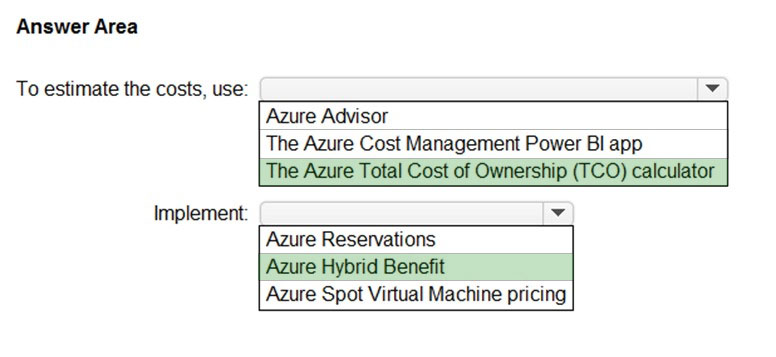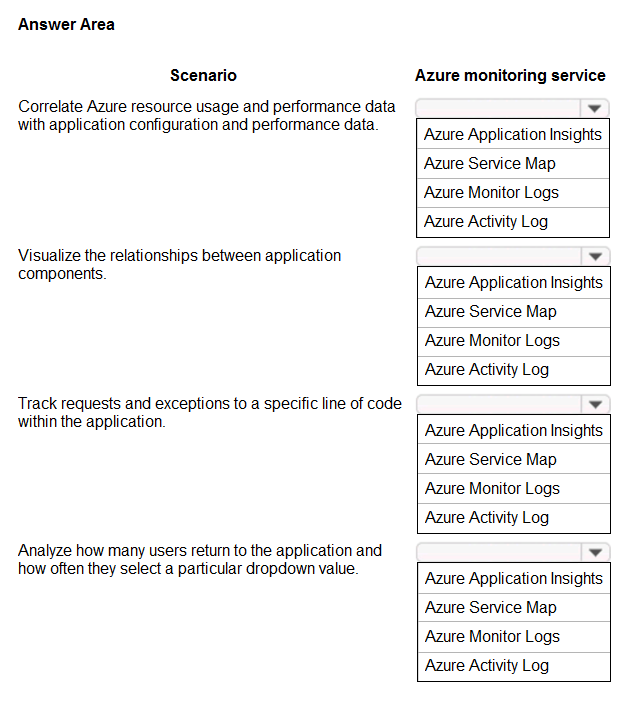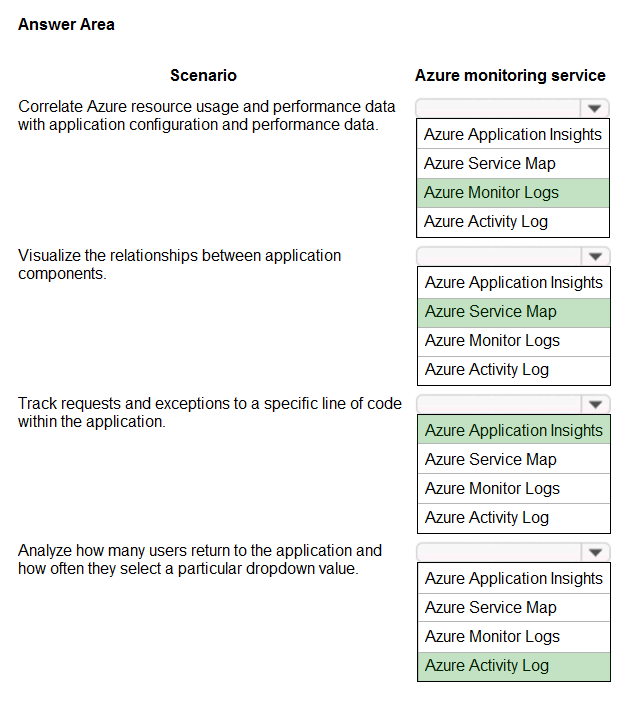Case Study -
This is a case study. Case studies are not timed separately. You can use as much exam time as you would like to complete each case. However, there may be additional case studies and sections on this exam. You must manage your time to ensure that you are able to complete all questions included on this exam in the time provided.
To answer the questions included in a case study, you will need to reference information that is provided in the case study. Case studies might contain exhibits and other resources that provide more information about the scenario that is described in the case study. Each question is independent of the other questions in this case study.
At the end of this case study, a review screen will appear. This screen allows you to review your answers and to make changes before you move to the next section of the exam. After you begin a new section, you cannot return to this section.
To start the case study -
To display the first question in this case study, click the Next button. Use the buttons in the left pane to explore the content of the case study before you answer the questions. Clicking these buttons displays information such as business requirements, existing environment, and problem statements. If the case study has an All Information tab, note that the information displayed is identical to the information displayed on the subsequent tabs. When you are ready to answer a question, click the Question button to return to the question.
Overview. General Overview -
Litware, Inc. is a medium-sized finance company.
Overview. Physical Locations -
Litware has a main office in Boston.
Existing Environment. Identity Environment
The network contains an Active Directory forest named Litware.com that is linked to an Azure Active Directory (Azure AD) tenant named Litware.com. All users have Azure Active Directory Premium P2 licenses.
Litware has a second Azure AD tenant named dev.Litware.com that is used as a development environment.
The Litware.com tenant has a conditional access policy named capolicy1. Capolicy1 requires that when users manage the Azure subscription for a production environment by using the Azure portal, they must connect from a hybrid Azure AD-joined device.
Existing Environment. Azure Environment
Litware has 10 Azure subscriptions that are linked to the Litware.com tenant and five Azure subscriptions that are linked to the dev.Litware.com tenant. All the subscriptions are in an Enterprise Agreement (EA).
The Litware.com tenant contains a custom Azure role-based access control (Azure RBAC) role named Role1 that grants the DataActions read permission to the blobs and files in Azure Storage.
Existing Environment. On-premises Environment
The on-premises network of Litware contains the resources shown in the following table.

Existing Environment. Network Environment
Litware has ExpressRoute connectivity to Azure.
Planned Changes and Requirements. Planned Changes
Litware plans to implement the following changes:
Migrate DB1 and DB2 to Azure.
Migrate App1 to Azure virtual machines.
Deploy the Azure virtual machines that will host App1 to Azure dedicated hosts.
Planned Changes and Requirements. Authentication and Authorization Requirements
Litware identifies the following authentication and authorization requirements:
Users that manage the production environment by using the Azure portal must connect from a hybrid Azure AD-joined device and authenticate by using Azure
Multi-Factor Authentication (MFA).
The Network Contributor built-in RBAC role must be used to grant permission to all the virtual networks in all the Azure subscriptions.

To access the resources in Azure, App1 must use the managed identity of the virtual machines that will host the app.
Role1 must be used to assign permissions to the storage accounts of all the Azure subscriptions.
RBAC roles must be applied at the highest level possible.
Planned Changes and Requirements. Resiliency Requirements
Litware identifies the following resiliency requirements:
Once migrated to Azure, DB1 and DB2 must meet the following requirements:
- Maintain availability if two availability zones in the local Azure region fail.
- Fail over automatically.
- Minimize I/O latency.
App1 must meet the following requirements:
- Be hosted in an Azure region that supports availability zones.
- Be hosted on Azure virtual machines that support automatic scaling.
- Maintain availability if two availability zones in the local Azure region fail.
Planned Changes and Requirements. Security and Compliance Requirements
Litware identifies the following security and compliance requirements:
Once App1 is migrated to Azure, you must ensure that new data can be written to the app, and the modification of new and existing data is prevented for a period of three years.
On-premises users and services must be able to access the Azure Storage account that will host the data in App1.
Access to the public endpoint of the Azure Storage account that will host the App1 data must be prevented.
All Azure SQL databases in the production environment must have Transparent Data Encryption (TDE) enabled.
App1 must not share physical hardware with other workloads.
Planned Changes and Requirements. Business Requirements
Litware identifies the following business requirements:
Minimize administrative effort.
Minimize costs.
HOTSPOT -
You plan to migrate App1 to Azure.
You need to estimate the compute costs for App1 in Azure. The solution must meet the security and compliance requirements.
What should you use to estimate the costs, and what should you implement to minimize the costs? To answer, select the appropriate options in the answer area.
NOTE: Each correct selection is worth one point.
Hot Area:

Answer :

Explanation:
Box 1: The Azure Total Cost of Ownership (TCO) Calculator
The Total Cost of Ownership (TCO) Calculator estimates the cost savings you can realize by migrating your workloads to Azure.
Note: The TCO Calculator recommends a set of equivalent services in Azure that will support your applications. Our analysis will show each cost area with an estimate of your on-premises spend versus your spend in Azure. There are several cost categories that either decrease or go away completely when you move workloads to the cloud.
Box 2: Azure Hybrid Benefit -
Azure Hybrid Benefit is a licensing benefit that helps you to significantly reduce the costs of running your workloads in the cloud. It works by letting you use your on-premises Software Assurance-enabled Windows Server and SQL Server licenses on Azure. And now, this benefit applies to RedHat and SUSE Linux subscriptions, too.
Scenario:
Litware identifies the following security and compliance requirements:
Once App1 is migrated to Azure, you must ensure that new data can be written to the app, and the modification of new and existing data is prevented for a

✑ On-premises users and services must be able to access the Azure Storage account that will host the data in App1.
✑ Access to the public endpoint of the Azure Storage account that will host the App1 data must be prevented.
✑ All Azure SQL databases in the production environment must have Transparent Data Encryption (TDE) enabled.
✑ App1 must not share physical hardware with other workloads.
Reference:
https://azure.microsoft.com/en-us/pricing/tco/
https://azure.microsoft.com/en-us/pricing/hybrid-benefit/
You need to recommend a solution to generate a monthly report of all the new Azure Resource Manager resource deployments in your subscription.
What should you include in the recommendation?
- A. the Change Tracking management solution
- B. Application Insights
- C. Azure Monitor action groups
- D. Azure Activity Log
Answer : D
Explanation:
Activity logs are kept for 90 days. You can query for any range of dates, as long as the starting date isn't more than 90 days in the past.
Through activity logs, you can determine:
✑ what operations were taken on the resources in your subscription
✑ who started the operation
✑ when the operation occurred
✑ the status of the operation
✑ the values of other properties that might help you research the operation
Reference:
https://docs.microsoft.com/en-us/azure/azure-resource-manager/management/view-activity-logs
You have an Azure subscription that contains an Azure SQL database named DB1.
Several queries that query the data in DB1 take a long time to execute.
You need to recommend a solution to identify the queries that take the longest to execute.
What should you include in the recommendation?
- A. SQL Database Advisor
- B. Azure Monitor
- C. Performance Recommendations
- D. Query Performance Insight
Answer : D
Explanation:
Query Performance Insight provides intelligent query analysis for single and pooled databases. It helps identify the top resource consuming and long-running queries in your workload. This helps you find the queries to optimize to improve overall workload performance and efficiently use the resource that you are paying for.
Reference:
https://docs.microsoft.com/en-us/azure/azure-sql/database/query-performance-insight-use
HOTSPOT -
You have an Azure App Service Web App that includes Azure Blob storage and an Azure SQL Database instance. The application is instrumented by using the
Application Insights SDK.
You need to design a monitoring solution for the web app.
Which Azure monitoring services should you use? To answer, select the appropriate Azure monitoring services in the answer area.
NOTE: Each correct selection is worth one point.
Hot Area:

Answer :

Explanation:
Note: You can select Logs from either the Azure Monitor menu or the Log Analytics workspaces menu.
Reference:
https://docs.microsoft.com/en-us/azure/azure-monitor/log-query/log-query-overview
You have an on-premises Hyper-V cluster. The cluster contains Hyper-V hosts that run Windows Server 2016 Datacenter. The hosts are licensed under a
Microsoft Enterprise Agreement that has Software Assurance.
The Hyper-V cluster contains 30 virtual machines that run Windows Server 2012 R2. Each virtual machine runs a different workload. The workloads have predictable consumption patterns.
You plan to replace the virtual machines with Azure virtual machines that run Windows Server 2016. The virtual machines will be sized according to the consumption pattern of each workload.
You need to recommend a solution to minimize the compute costs of the Azure virtual machines.
Which two recommendations should you include in the solution? Each correct answer presents part of the solution.
NOTE: Each correct selection is worth one point.
- A. Configure a spending limit in the Azure account center.
- B. Create a virtual machine scale set that uses autoscaling.
- C. Activate Azure Hybrid Benefit for the Azure virtual machines.
- D. Purchase Azure Reserved Virtual Machine Instances for the Azure virtual machines.
- E. Create a lab in Azure DevTest Labs and place the Azure virtual machines in the lab.
Answer : CD
Explanation:
C: For customers with Software Assurance, Azure Hybrid Benefit for Windows Server allows you to use your on-premises Windows Server licenses and run
Windows virtual machines on Azure at a reduced cost. You can use Azure Hybrid Benefit for Windows Server to deploy new virtual machines with Windows OS.
D: With Azure Reserved VM Instances (RIs) you reserve virtual machines in advance and save up to 80 percent.
Reference:
https://azure.microsoft.com/en-us/pricing/reserved-vm-instances/ https://docs.microsoft.com/en-us/azure/virtual-machines/windows/hybrid-use-benefit-licensing

